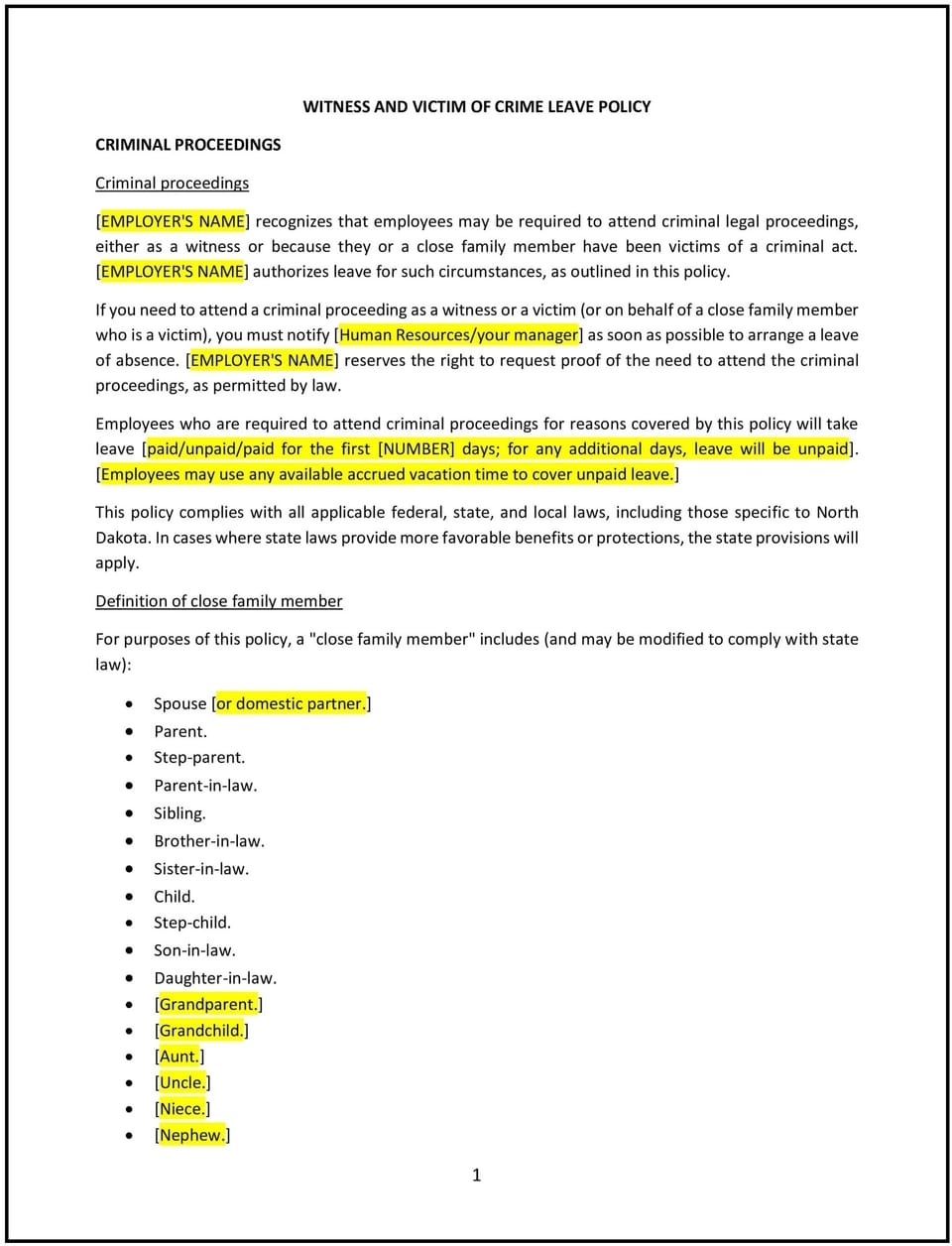Witness and victim of crime leave policy (North Dakota): Free template

Witness and victim of crime leave policy (North Dakota)
This witness and victim of crime leave policy is designed to help North Dakota businesses support employees who are victims of or witnesses to a crime. It outlines procedures for granting leave, job protection, and compensation during their absence.
By adopting this policy, businesses can demonstrate compassion, comply with state laws, and foster a supportive workplace culture.
How to use this witness and victim of crime leave policy (North Dakota)
- Define eligibility: Specify which employees are eligible for leave, such as victims of or witnesses to a crime.
- Outline leave types: Describe the types of leave available, such as time off for court appearances, medical appointments, or counseling.
- Establish request procedures: Provide steps for employees to request leave, including required documentation and notice.
- Address job protection: Explain how employees’ jobs will be protected during their absence, in compliance with state laws.
- Specify compensation: Clarify whether employees will be paid during their leave, in accordance with the business’s policies.
- Train managers: Educate supervisors on handling leave requests and supporting employees during their absence.
- Review and update: Assess the policy annually to strengthen alignment with evolving workplace needs and legal standards.
Benefits of using this witness and victim of crime leave policy (North Dakota)
This policy offers several advantages for North Dakota businesses:
- Demonstrates compassion: Supports employees during difficult times, fostering a caring workplace culture.
- Enhances compliance: Strengthens alignment with state laws, such as North Dakota’s victim protection statutes.
- Reduces stress: Provides employees with the time they need to address legal or emotional needs related to a crime.
- Builds trust: Shows employees that the business values their well-being and contributions.
- Attracts talent: Highlights the business’s commitment to supporting employees, making it more attractive to potential hires.
Tips for using this witness and victim of crime leave policy (North Dakota)
- Communicate clearly: Ensure all employees understand the policy and their rights regarding leave.
- Provide training: Educate managers on handling leave requests with sensitivity and fairness.
- Encourage transparency: Foster a culture where employees feel comfortable requesting leave without fear of retaliation.
- Monitor compliance: Regularly review the policy to ensure adherence to state laws and workplace needs.
- Update regularly: Review the policy annually to strengthen alignment with evolving workplace needs and legal standards.
Q: How does this policy benefit businesses?
A: It demonstrates compassion, enhances compliance, and supports employees who are victims of or witnesses to a crime.
Q: Who is eligible for this leave?
A: Employees who are victims of or witnesses to a crime are eligible, as outlined in the policy.
Q: Is this leave paid or unpaid?
A: This depends on the business’s policy. Some businesses offer paid leave, while others provide unpaid leave in compliance with state laws.
Q: How much leave is provided?
A: The duration varies, but businesses typically provide leave for court appearances, medical appointments, or counseling.
Q: How often should businesses review this policy?
A: Businesses should review the policy annually or as needed to strengthen alignment with evolving workplace needs and legal standards.
This article contains general legal information and does not contain legal advice. Cobrief is not a law firm or a substitute for an attorney or law firm. The law is complex and changes often. For legal advice, please ask a lawyer.


